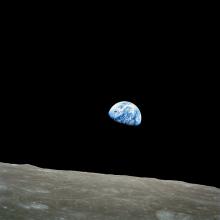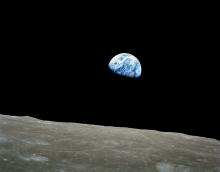Listen to today's episode of StarDate on the web the same day it airs in high-quality streaming audio without any extra ads or announcements. Choose a $8 one-month pass, or listen every day for a year for just $30.
You are here
Moon and Companions
The Moon forms a beautiful triangle with two brilliant planets this evening. Venus, the “evening star,” is close to the lower left of the Moon, with fainter Jupiter farther to the upper left.
The gravitational influence of the two planets may play a big role in changes in Earth’s orbit. Their pull is stronger than those of the other planets because Venus is our closest neighbor, while Jupiter is the heaviest planet in the solar system.
Their combined pull may cause Earth’s orbit to change over a period of about 400,000 years. At one extreme in that cycle, the orbit would be almost circular, with little variation in our distance from the Sun. At the other extreme, the orbit would be more stretched out, so our distance from the Sun would vary by about 10 million miles. Today, we’re between those extremes, with the distance varying by three million miles.
Scientists recently found new evidence of this cycle in rock cores from Arizona. Previous studies had found similar evidence in other locations. But the new study had better evidence, and extended the record back to more than 200 million years ago.
Scientists say the variations in Earth’s orbit would magnify the effects of smaller climate cycles. Wet periods would get wetter, for example, or cold periods colder. And the variations could have caused a delay in the time it took the dinosaurs to become the dominant life on Earth — variations pumped up by two bright planets.
Script by Damond Benningfield





